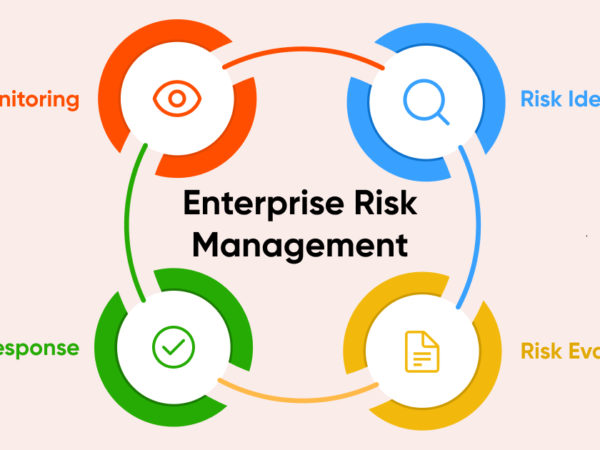<img alt="Data Exfiltration and Best Practices to Defend Against It" data- data-src="https://kirelos.com/wp-content/uploads/2023/09/echo/Data-Exfiltration-and-Best-Practices-to-Defend-Against-It.jpg/w=800" data- decoding="async" height="420" src="data:image/svg xml,” width=”800″>
Data exfiltration is one of the major cyber-attacks that pose a significant threat to organizations. It can be carried out by malicious insiders, external attackers, or even accidental means.
According to Statista, the global average cost per data breach in 2023 is $4.45 million, while the average cost of a data breach in the United States is $9.48 million. Data exfiltration can devastate an organization, leading to financial losses, reputational damage, and even legal liability.
This guide will explore the concept of data exfiltration, the methods used by cyber adversaries, and the essential steps that can be taken to mitigate the risk and protect against data loss.
What is Data Exfiltration?
Data exfiltration, also known as data extrusion or data exportation, is the unauthorized transfer of data manually or automated from a computer or server. Data exfiltration simply involves the copying or accessing of a company’s data by either having direct access to a physical device or through the use of the internet to gain access to the system.
Hackers have devised various means of gaining access to data, making it possible to detect some of the methods used in accessing the company’s system. Data exfiltration cannot be easily detected as it simply involves the transfer or copying of data, which resembles a typical everyday activity in any system.
Real-Life Examples of Data Exfiltration
Data exfiltration can be carried out internally by an employee of an organization as well as externally by a competitor or hacker. Here are some real-life examples of data exfiltration
#1. Equifax data breach
In 2017, Equifax, an American multinational consumer credit reporting agency, was a victim of data exfiltration. The personal and financial data of 143 million consumers were exposed due to security lapses in the company’s system, and over a terabyte worth of data was exfiltrated by the attackers. These led to legal and regulatory fines and loss of customer trust; it also led to Equifax spending over $ 1.4 billion on cleanup costs after the breach.
#2. SolarWinds cyberattack
In 2020, a data breach occurred at SolarWinds, which affected thousands of organizations worldwide, including the US government, estimated at 18,000 systems worldwide.
The attackers were able to install malicious code on customers’ systems, which granted them access to exfiltrate large amounts of data, including customers’ passwords, financial information, and intellectual properties, causing irreparable damage worth over $40 million as recorded in the company’s quarterly report.
#3. Yahoo breach
In 2013, over 3 billion users‘ personal information was exfiltrated from Yahoo in a data breach. If you had a Yahoo account as of 2013, there’s a high probability that your data must have been involved. The attackers breached and stole account information such as names, email addresses, phone numbers, birth dates, and hashed passwords.
The breach, which was only disclosed by the company in 2016, led to a devaluation of Yahoo’s price when it was acquired by Verizon, as well as facing lawsuits and regulatory fines.
How Does Data Exfiltration Work
In the previous section, we had a view of cases involving data exfiltration and how this breach affected the companies, ranging from financial losses to reputational damages. Data exfiltration occurs most times due to a vulnerability in a company system. In this section, we will go over how data exfiltration will likely occur in a system.
As we noted, data exfiltration can occur in two primary ways: through an insider or an outsider attack.
An insider attack could happen as a result of ignorance, through social engineering from an external attacker where an employee accesses a phishing email and the attacker uses that platform to input malicious code into the organization system and gain access to data or intentionally in the case where an employee has a thing against the company and copy sensitive information with the intention to make a gain.
In an external attack, an attacker could install malicious code over a network or through gaining access to a physical device. Another method of vulnerability could occur when an organization uses a third-party vendor software.
Types of Data Exfiltration
Knowing the various types of data exfiltration could help you create a data protection strategy to safeguard your enterprise system.
Outbound emails
With thousands of emails being sent every day, attacker leverage communication channels such as emails and phone calls, among others, to send sensitive data from their secure computers to insecure or personal systems.
This information can be sent as a file attachment, text message, or email in plain text, which could be used in stealing source code, calendar information, pictures, financial records, and databases.
Upload to external/personal devices
This type of exfiltration occurs from an insider attack, where an employee copies or download information from the company’s secure network or device and then upload it to an external device to be used outside of the authorized premises.
Cloud vulnerabilities
Most organizations are moving to store data in the cloud. The cloud providers manage these cloud services and storage, and the cloud environment can be vulnerable to exfiltration if they are not properly protected or configured.
Unauthorized software
When company employees use unauthorized software within an organization, it could result in a security vulnerability. Any software could contain malware that harvests data from a user’s device. When an employee downloads software not vetted and approved by the organization, attackers could leverage that to exfiltrate data.
Best Practice to Prevent Data Exfiltration
There are various tools to help detect irregular activities on the system, as well as best practices to keep attackers and hijackers off from organization systems. Let us highlight some of the best practices involved in preventing data exfiltration.
Monitor activity
Every system has a regular pattern in which data flow is carried out, and these activities can be monitored. Consistently monitoring user activities is essential to the early detection of excessive network or data transfer activities from a particular user and helps flag unusual behavior.
A network monitoring tool can help organizations track who accessed what files and what was done with the files.
Identity and access management (IAM)
Alongside the continuous monitoring of users’ activities within an organization system, it is essential to manage access and privileges for users. This will help secure data from being accessed by unauthorized persons, giving only the right users access to the appropriate resources they need.
Secure password
The first layer of security in most systems starts with a password. Ensure that users use a unique password when creating an account to help reduce the chances of their passwords being guessed.
Password combinations that contain special characters, letters (upper and lower case), and numbers will be difficult to crack compared to one that does not contain such a combination. Avoid using a single password on multiple accounts to prevent exposure in the occurrence of a breach.
Update software and systems
Keeping all software and systems updated should be a priority to ensure that vulnerabilities in previous versions get fixed when a patch is made available and that the latest security patches are also included in your system.
Use encryption
Encryption involves converting information/data into code, making it difficult for unauthorized users to access. Encrypting enterprise data within the company system and only decrypting the data when accessed by an authorized user helps protect sensitive information during data exfiltration.
Data loss protection (DLP) tools
The use of data loss protection tools helps an organization to actively monitor data transfer and detect suspicious activity within the system. DLP also helps analyze the data being transferred to detect sensitive content in them. Let’s review some DLP tools that could help prevent attacks like data exfiltration.
#1. StrongDM
<img alt="YouTube video" data-pin-nopin="true" data-src="https://kirelos.com/wp-content/uploads/2023/09/echo/maxresdefault.jpg65045354b6d4a.jpg" height="720" nopin="nopin" src="data:image/svg xml,” width=”1280″>
Strongdm is a dynamic access management platform that helps users manage privileged data and activity monitoring of users’ actions within the system. It supports real-time management of every permission within the system and has the ability to revoke access when suspicious activity is detected.
Strongdm offers various solutions, including privilege session management, permission management, JIT access, cloud PAM, logging, and reporting, among other features. StrongDM pricing starts at $70 per user per month.
#2. Proofpoint
<img alt="YouTube video" data-pin-nopin="true" data-src="https://kirelos.com/wp-content/uploads/2023/09/echo/maxresdefault.jpg65045354c39fe.jpg" height="720" nopin="nopin" src="data:image/svg xml,” width=”1280″>
Another DLP tool that could help prevent data exfiltration is Proofpoint Enterprise DLP. Proofpoint helps with the prevention of data loss and the investigation of policy violations within a system. It also helps to ensure strict compliance with policies to help reduce the risk attached to non-compliance.
Proofpoint solutions cover email and cloud threats, user behavior activities, preventing data loss and insider attackers, protection of cloud apps, and loss from ransomware. Proofpoint offers a 30-day free trial, and pricing is available upon request.
#3. Forcepoint
<img alt="YouTube video" data-pin-nopin="true" data-src="https://kirelos.com/wp-content/uploads/2023/09/echo/maxresdefault.jpg65045354da643.jpg" height="720" nopin="nopin" src="data:image/svg xml,” width=”1280″>
Forcepoint uses ML to analyze and detect abnormal user activities within a system. It helps prevent data exfiltration on a wide range of devices in real time. The tool features include centralized data security policy management and simplified DLP management with over 190 pre-defined data security policies.
#4. Fortnite
<img alt="YouTube video" data-pin-nopin="true" data-src="https://kirelos.com/wp-content/uploads/2023/09/echo/maxresdefault.jpg65045354ec7fd.jpg" height="720" nopin="nopin" src="data:image/svg xml,” width=”1280″>
Fortinet is one of the most advanced tools in the space; its NGFW provides protection from various forms of cyberattacks, such as malicious traffic, prevents data exfiltration, and enforces security policies.
Fornite NGFWs offers a wide range of features, such as intrusion prevention systems, application controls, anti-malware, web filtering, cloud-based threat intelligence, and data loss protection. The tool can be deployed across various locations such as remote offices, branches, campuses, data centers, and the cloud.
Conclusion
Data security is crucial for every organization to help maintain user trust and avoid regulatory issues. It is important for every organization that holds any form of data to employ safety and preventive mechanisms to avoid being breached and data exfiltrated from their system.
Note that as the majority of the focus of securing the system is on outside threats, insider threats should also be handled properly to avoid leaving a loophole in an organization’s system, as they could do as much damage as the outside threat.
You may also explore some different types of DDoS attacks and how to prevent them.



